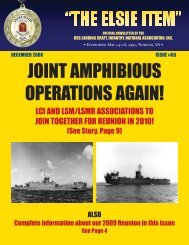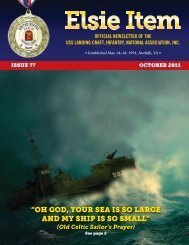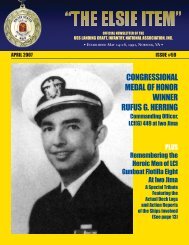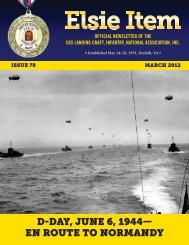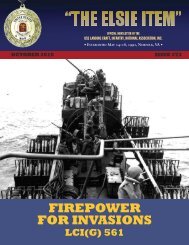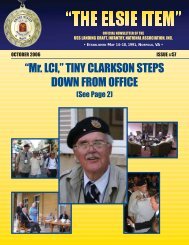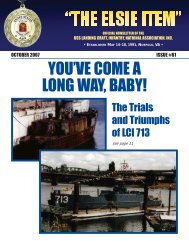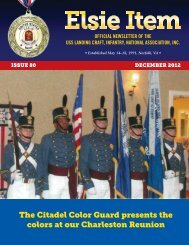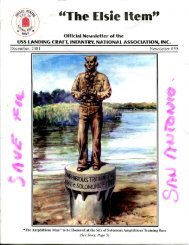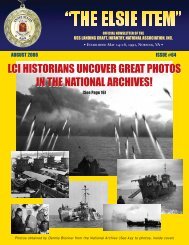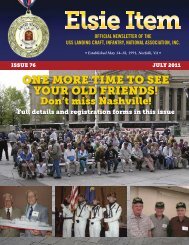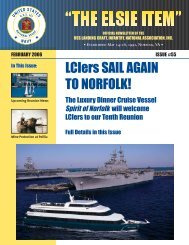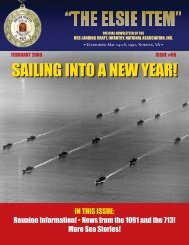elsie item issue 67 - USS Landing Craft Infantry National Association
elsie item issue 67 - USS Landing Craft Infantry National Association
elsie item issue 67 - USS Landing Craft Infantry National Association
- No tags were found...
Create successful ePaper yourself
Turn your PDF publications into a flip-book with our unique Google optimized e-Paper software.
From the Editor/PresidentPortland, Here We Come!By the time you receive this <strong>issue</strong> our Portland Reunion will be only a matterof weeks away, and we will be in full scale anticipation of a great time together.Seeing old shipmates again – and meeting friends and family of those shipmateswill be the great attraction, but this year our experience will be evenmore memorable with <strong>USS</strong> LCI(L) 713 moored right there where we can see itfrom our hospitality room. If funding problems can be solved, we may alsohave the pleasure of seeing the 1091 there. We’re hoping for a record turnout and look forward to seeing YOU there!And for you Affiliates: Board member Joe Flynn, hoping for as large a turn-out of affiliate members as possible,has penned a special letter to all affiliates which we include in this <strong>issue</strong>. We urge you to read it.Joint LCI/LSM Reunion in 2010!I’m very pleased to report that plans are firming up for our joint reunion with the LSM/LSMR group in 2010.After conferences with Dave Miller, President of their group, and Ted Dey of Armed Forces Reunions, we havedecided on a meeting at the Millenium Hotel in Cincinnati, Ohio, July 25-29, 2010. Mark your calendars now!Our Membership/Financial PictureGrowth in both regular and affiliate membership during this past year has been most encouraging. Though agehas taken its toll on our LCIers, we are very pleased with the number of affiliate members who have comeaboard and believe that our future lies in their taking more and more leadership roles. Finances pose someproblems and will need careful attention from your Board as they consider a budget for next year. We willdraw down our assets a bit this year and will undoubtedly have to do so next year. However, our reserves aresuch that we could operate several years into the future by continuing to draw on them. We are hopeful thatdues and donations will continue to come in strong so that draw downs will be minimal. As we enter into seriousdiscussions with the LSM/LSMR group there are encouraging possibilities about the strength we coulddraw from each other and savings that could be realized by combining our operations. As we think throughthese and related <strong>issue</strong>s, your ideas and comments will be most welcome.About This Issue:This <strong>issue</strong> features the longest article we have ever carried. In fact, LCI Historian/VP John France’s account ofthe part played by LCI Flotilla 12, Group 34 at Normandy almost raises our status to that of a professional militaryhistory magazine. It is, by far, the most exhaustively researched, detailed account of an LCI operation wehave seen. It is such an outstanding piece of work that we took the unusual step of including it all in this one<strong>issue</strong>. We are confident you will enjoy the account of Group Commander Lindsey R. Henry’s “FortunateRedirection” every bit as much as we did.Retired Professor Ralph Langenheim gives us another fascinating account of the post WWII service ofLCIs. This one involves the infamous CIA-directed:”Bay of Pig”s attempted invasion of Cuba in 1961 in anattempt to overthrow Fidel Castro.A third significant piece concerns the efforts made by Stan Lasik, one of our affiliate members, to return aNavy-<strong>issue</strong>d sheath knife to the family of its original owner. We’re particularly happy to share this story withyou because it illustrates the significance of the work of remembering LCIers and their crews by our affiliates.Stan, in establishing a website memorializing his father and engaging in such activity as he recounts here,sets a standard and, by example, invites other affiliate members to join in such activity.—John Cummer3
More Photos from the Archives: LCIs at NormandyLoaded with troops, C-47s fly low over an LCIFour soldiers lay around... Yeah! It was a bitcrowded at times!A hot meal—take it where you can get it!The <strong>USS</strong> Arkansas fires a broadside. If youreyes are good you may be able to make outthat LCI just astern. Probably woke theskipper up!U.S. Army troops embark LCI 539 from an LCVP4
A Special Message to My Fellow Affiliates of the<strong>USS</strong> LCI <strong>National</strong> <strong>Association</strong>I want to join President John Cummer in extending a special invitation to all affiliate members toattend the 2009 <strong>National</strong> LCI Reunion May 13 through 17 in Portland, OR. We will have a meetingspecifically designed to assist Affiliates in doing research on LCI Veterans, and preserving thehistory of the LCI’s and the men who sailed them, but there will be much more to the Portlandexperience.At this Reunion we will have one, and possibly two, of the last restored LCI’s afloat at dockside atour reunion hotel, the Red Lion on the River. You will be able to go aboard the <strong>USS</strong> LCI 713 and, ifshe is able to make the voyage up from Humbolt Bay, the <strong>USS</strong> LCI 1091.Let me tell you of my experience in first seeing an LCI: When I went aboard the 1091 in Eureka,CA, I could for the first time see and feel a ship like the one my brother served on in the campaignin the Pacific for over two years. You may know that the LCI was the smallest ship in the Navy ofthat time capable of crossing oceans under its own power. After two or even more years aboard Iam sure it must have seemed much smaller. I was able to see crew’s quarters, galley, mess deck,engine room, troop compartments, officer’s quarters, conning tower and the various battle stations.I could visualize the action that took place during the invasions. I saw my brother’s battlestation on the aft port 20 mm; the place where, during the Saipan invasion, one of his shipmateswas standing when he was mortally wounded by shrapnel. I saw the crew’s quarters where hewas taken, and where his last conversation was recorded by my brother. You, hopefully accompaniedby your LCI relative, will have the opportunity to have your own special experience.The opportunity to go aboard an LCI is, by itself, worth the trip to Portland. But In addition youwill have the opportunity to meet, talk with and hear the stories first hand from the men whosailed these small ships into battle and onto enemy shores. These aging salt water warriors willstand a little straighter and pick up a little spring in their step as they once again walk the steeldecks and tell you of life aboard “their” LCI.The 713 and the 1091 will, hopefully, be with us for many years yet, but we need to rememberthat opportunities to meet and talk with these LCI sailors in the future will lessen. Even thosewho joined the Navy right out of high school in 1942 are now in their mid-eighties. Make theirday! Being with you on the decks of an LCI might just be one of their most treasured moments.I urge you accept President Cummer’s invitation and be part of the 2009 reunion in Portland .See you in Portland,Joe Flynn,Board Member and AffiliatePS See your last edition of Elsie Item for complete reunion information and registration forms.5
A Word from Chaplain MikeHave a Nice Life!Ex-baseball catcher and television co-host, Joe Garagiola once recalled a visit he made to a localdrug store. He said:“From the shelves I selected a bottle of Extra-Strength Tylenol, twelve ounces of Kaopectate,an elastic knee support, a supply of corn plasters, some Dristan, a vaporizer, a remedy forsore gums, and a tube of Preparation H. I took all of that stuff to the counter, where theyrung me up on the register and bagged them. Then as the clerk handed me my purchases, Icouldn’t believe my ears, when I heard him say, ‘Have a nice day!’”If I should say to you now, “Have a nice day,” some of you may feel like saying, “I can’t believe myears. Gatton has no idea what I’m going through. Have a nice day! Are you kidding?” And youwould probably be right in feeling that way. I really don’t know what you are going through today.Only God knows. And, that’s the whole point of our faith. God knows and God cares! God promisednever to abandon us. God’s love is steadfast. God has promised to relieve all anxiety, right everywrong, and wipe away every tear.Believe your ears when you hear the Word of God telling you not only to “have a nice day,” but to“have a nice life.” Believe your ears when you hear God reassuring you that, whatever you’re goingthrough today, it’s all worthwhile. Whatever you’re going through today, it’s going to be all right.Whatever you’re going through today, God is with you.Have a nice day! Have a nice life! That’s God’s wish for you now and forever. You can believe yourears.A Prayer: Help us, God, to believe our ears when we hear your promise of the good life. Help us,God, to help others to believe their ears, when by sharing love, we give them little glimpses of yourtremendous love. Amen.Agape, Chaplain Mike6
Letters to the EditorJohn,I enjoyed the article in the February Elsie Itemby Dennis Blocker about LCI 341 in NewGuinea’s Lae <strong>Landing</strong>s on September 4, 1943.My father’s ship, LCI 226 was also there and theaction is mentioned in the March 27, 1944 LifeMagazine article that chronicles LCI 226 fromcommissioning to the landings at CapeGloucester, New Britain.For the record, there was one little error inthe article. It said that LCI 341 picked up theAustralian troops and left “the soft sands ofHollandia and began her perilous journey …destination,Lae, New Guinea.” Actually, Hollandia(current day Jayapura) is 700 miles further upthe north coast of New Guinea from Lae and wasstill in Japanese hands until April 22, 1944.The flotilla that LCI 226 was in left Cairns,Australia and arrived in Milne Bay at the southeasttip of New Guinea on August 25, 1943 andmade their home base there. In early Septemberthey came 200 miles up the coast of NewGuinea to pick up troops from the Australian 9thArmy at Buna to deliver 200 miles further up thecoast at Lae. The Australian 9th Army was partof the famed “Rats of Tobruk” who withstood the1941 siege in Libya, Africa by Germany’s AfrikaKorps led by Rommel. I believe the Australianshad marched 100 miles northeast across thatpart of New Guinea from Port Moresby on thesouth coast which was taken a year earlier inSeptember 1942.Ardie HuntLCI(L) 226Carson City, NVDear Mr. Cummer,I read with tremendous interest your article “<strong>USS</strong>LCI 502 at D-Day.” My father gave the <strong>issue</strong> of“The Elsie Item” to me when he finished it. In1944 my Dad was the captain of LCI 500 which,like you, took part in the invasion at Gold Beach.My Dad is almost 91 now and lives in a communityin Massachusetts. He is in excellenthealth, both mental and physical, despite theloss of my mother last year, his companion of 74years. I regularly question him about his experiencesin the Normandy Invasion because thesubject interests me.I am wondering if you have any memories ofmy Dad (Lt. Albert Ullman) or the 500 ? Perhapsone thing could jog your mind. My father appointeda black man as the bow gunner and in the segregatedNavy back then this assignment wasnotable. I have spoken to this man, PhillipBuchanan, at length on the phone and he is trulygrateful to Dad to this day. They met for the firsttime since the war at the dedication of the WW2Memorial in DC several years ago.Regards to you,Richard UllmanKate/Richard UllmanJohn,Thanks for sharing your story about the 502. Iwish I had the talent to put down on paper asyou did-about our LCI (g) escapades during thesix island hopping invasions in the Pacific.John, I was captivated by the photo of the LCIsin columns I looked in vain thru out the <strong>issue</strong> toget info about the photo. Can you provide anyinfo- what, where etc. Thank you for all thegreat work you are doing to keep the associationalive and kicking,Harold Radcliffe MOMM2/classLCI (G) 475Editor’s Note: Sorry! Dennis Blocker says hewas unable to get an identification on thatphoto. It was so good, though, we thought ithad to be used.7
John:On this date, Feb. 17, 1945, the ships of LCIGroup 8, Flotilla 3 and their flagship with Cdr.M.J. Malanaphy in Command, participated in theBeach Reconnisance Operation in support of theUnderwater Demolition Teams at IWO JIMA. Thisoperation was highly classified and the resultswere not known by the public for many years.Participating LCI(G)s were: 346, 348, 438, 441,449, 450, 457(Group Flag), 466, 469, 471,473, 474 and 627FF. All of the ships sustainedmultiple hits from shore batteries with very highcasualties. One LCI, the 474, was sunk.The CO of the 449, LTJG Rufus Herring, wasawarded the Medal of Honor, the COs of theother ships in the operation were awarded theNavy Cross. Many Silver and Bronze Stars wereawarded to the Officers and Crews of theseships as well as Purple Hearts to all wounded.Casualties ran in excess of 30 percent.For this action, Group 8, Flotilla 3 were presentedthe Presidential Unit Citation with a star.SHIPMATES, both living and passed on, ISALUTE YOU for your performance on this dateoff the island of IWO JIMA. VALOR and BEYONDTHE CALL OF DUTY were common phrases in usefor about 90 minutes that day. The lives of manywere permanently changed on that Februarymorning 64 years ago.Ensign Robert J. HarkerEngineering Officer<strong>USS</strong> LCI(G) 474Welcome Aboard!A hearty welcome to these new regular and affiliate members!Just in time for the Portland Reunion!Regular MembersJames D. Robertson,LCI (G) 64Albuquerque, NMEugene Deragon,LCI 223 & 549Lamar, SCRobert L. Knutson,LCI 564Lafayette, CAAllan Flood,LCI 798Ft. Wayne, INAffiliate MembersMartin Forman,Scarsdale, NYSteven Forman,Millersville, MDDavid Read,Stockton, CA8
The Fortunate Redirection:<strong>Landing</strong> <strong>Craft</strong> <strong>Infantry</strong> (LCI) Group 34 of Flotilla 12 At NormandyByJohn France,<strong>USS</strong> LCI <strong>National</strong> <strong>Association</strong> Historian for The European TheaterLCIs of Group 34, Flotilla 12, lead the way on the assault of Omaha Beach!THROUGHOUT THE HISTORY OF WARFARE, thebest made battle plans often went awry shortlyafter the first projectile was unleashed.Therefore, the responsibility of pressing theattack fell upon the shoulders of decisive warriorswho took the initiative, those who couldadapt to the situation and overcome the obstacles.Omaha Beach, June 6, 1944 was chaoticand deadly. Many soldiers and sailors of all rankshad to take the initiative in order to prevail thatday. Many of the landings on D Day were notmade at their designated areas, some because ofthe cross current, some because of poor navigationand some because of panic in the fog of war.However, there were some purposeful redirections,most notably by <strong>Landing</strong> <strong>Craft</strong> <strong>Infantry</strong>(LCI) Group 34 of Flotilla 12 that helped changethe course of the battle by placing approximately2,400 fresh troops exactly where they wereneeded. Sixty-four years after the landings, manysailors of the <strong>Landing</strong> <strong>Craft</strong> <strong>Infantry</strong> (LCIs) ofGroup 34 still do not know that they landed farfrom their designated beaches nor are they awareof their significant contribution towards victory inthat great battle.The beach known as “Omaha” was a crescentshaped beach on the Normandy coastline ofnorthern France, more than 11,000 yards inlength. To the east were the designated Britishand Canadian beaches of “Gold”, “Juno” and“Sword”. To the west of Omaha Beach were thecliffs of Pointe du Hoc and beyond “Utah” beach,the other American objectives on D Day. TheU.S. forces of Omaha and Utah Beaches wereunder the command of Lieutenant General Omar9
Bradley. There were thousands of vessels in theinvasion force and <strong>Landing</strong> <strong>Craft</strong> <strong>Infantry</strong> (LCIs)played a prominent role in delivering troops to theNormandy shore. Allied planners divided OmahaBeach into eight different beach sectorsThe Beaches of Omaha[See map, next page]From west to east (Facing Omaha Beach fromthe sea, these sectors were located from right toleft) they were designated as “Charlie” – 2,320yards, “Dog Green” – 970 yards, “Dog White” –700 yards, “Dog Red” – 480 yards, “Easy Green”– 830 yards, “Easy Red” – 1,650 yards, “FoxGreen” – 1,135 yards and “Fox Red” – 3,015yards. There were five “draws” that led awayfrom the beaches inland designated from west toeast (right to left facing them from the sea) as“D-1”, “D-3”, “E-1”, “E-3” and “F-1”. Three ofthese “draws” had roads that lead to a nearbytown – “D-1” draw in front of Vierville, “D-3” drawat Les Moulins and “E-3” draw leading toCollville. The large “E-1” – The St. Laurent Drawdid not have a road but it was centrally locatedbetween “D-3” and “E-3”. “F-1” draw was thesmallest of the draws, did not have a road andwas located at the most eastern sector of beach– “Fox Red”. The Allied planners stacked mostof the assault forces near these draws in order toquickly exploit these exits from the beach andover the bluffs. The Germans also realized theimportance of the draws and built concretestrong points with artillery, mortars and machinegunsto defend them.The U.S. Army V Corps commanded by MajorGeneral Leonard T. Gerow was assigned theassault of Omaha Beach. The 29th <strong>Infantry</strong>Division consisting of the 116th and 115thRegimental Combat Teams (RCT) was to assaultthe western half of Omaha Beach on D Day (andfollowed the following day by the 175th RCT ofthe 29th <strong>Infantry</strong> Division). The 1st <strong>Infantry</strong>Division, “Big Red One” consisting of the 16thand 18th Regimental Combat Teams was toassault the eastern sectors of Omaha Beach onD Day with their reserve infantry regiment – the26th RCT landing on D Day after 6PM. The “BigRed One” had a nucleus of combat veterans fromthe African and Sicily campaigns. The 29thDivision had not faced shots fired in anger butthey were superbly trained. The 29th Divisionwas a <strong>National</strong> Guard unit originally comprised ofvarious units from Maryland and Virginia that hadfought each other during the Civil War.Companies of the 115th Regiment were originallyformed in towns throughout Maryland and the116th Regiment from Virginia. The insignia of the29th was a “Yin and Yang” circular patch of Blueand Gray. Their motto was “29, Let’s Go!”The Battle is JoinedThe first wave of infantry, carried by small British<strong>Landing</strong> <strong>Craft</strong> Assault craft (LCAs) and American<strong>Landing</strong> <strong>Craft</strong>, Vehicle, Personnel (LCVPs) eachwith a capacity of thirty-six soldiers began hittingOmaha Beaches at 6:30 AM on D Day. Theywere joined by a variety of other units includingcombined Army and Navy Special EngineerBrigades whose tasks were to clear and markchannels through the beach obstacles.Casualties were extreme and few channels werecleared and none of them were marked.Waiting for the opportunity to deliver their troopsto the beach, were the crews of <strong>Landing</strong> <strong>Craft</strong><strong>Infantry</strong> (LCI) Group 34 of Flotilla 12. Thesetwelve LCIs carried the bulk of the 115th <strong>Infantry</strong>Regiment of the 29th Division – approximately2,400 soldiers. LCIs 412, 554, 411 and 413carried the 1st Battalion – Companies A, B, C,and D. LCIs 408, 553, 409 and 410 carried the2nd Battalion – Companies E, F, G, H includingRegiment Headquarters Staff. LCIs 540, 541,555 and 557 carried the 3rd Battalion –Companies I, K, L and M.The commander of LCI (L) Group 34 was LindsayR. Henry. Henry was born July 10, 1900 inBrooklyn, NY. He was a month shy of his 44thbirthday on D Day. Prior to the war he was anAssistant U.S. Attorney for the Eastern District ofNew York. In that capacity in 1938, he was thefirst prosecutor in the U.S. to take on the Nazis.He prosecuted Fritz Kuhn and the German10
Reproduced from D-Day, by Stephen E. Ambrose. Simon & Schuster, New York, 199411
American Bund, for seditious activities. Believingthat war was looming on the horizon in 1940,Henry applied for active duty in the Navy. At thattime he held a commission as Lieutenant in theU.S. Navy Reserves. Due to his legal background,he was assigned to Naval Intelligence.For 18 months after the attack on Pearl Harbor,Henry mailed more than thirty letters requestingsea duty. Finally, in 1943 he was off to amphibioustraining at Solomons, Maryland and his eventualcommand of LCI(L) Group 34. His Flagshipwas LCI(L) 408. (Source: Lindsay Henry andThomas Henry)On D-Day, LCI Group 34 was supposed to land the115th RCT on “Dog Red” and “Easy Green” sectorsin front of “D-3” draw at Les Moulins at9:30AM. However, shortly after 9AM, GeneralOmar Bradley was considering canceling the invasiondue to the carnage and stalemate on thebeaches. Off to Henry’s right front (west) lay“Dog White” sector which was adjacent to hisdesignated landing area. There, two LCIs- CoastGuard 91 and 92 from Flotilla 10 were ablazeafter being destroyed while attempting to landtroops. LCI 91 carrying “B” Company, 147thEngineers and HQ 116th RCT were the first toland in that sector at 7:40AM, followed by LCI92 at 8:10AM carrying “C” Company, 147thEngineers and “A” Company, 7th BeachBattalion. These two burning LCIs were clearwarnings to all who intended to follow. LCI 94,carrying “B” Company, 104th Medical Battalionand the 29th MP Platoon narrowly escaped disasterby landing east of LCI 91 on “Dog Red” sector.(Source: Balkoski)Henry Makes a Decision“Dog Red” was one of Group 34s designatedbeach sectors but the beach in front of LindsayHenry was a mess and he could not locate a controlvessel that would guide them to the beach.Henry signaled the Navy command ship <strong>USS</strong>Ancon and asked for instructions. <strong>USS</strong> Anconflashed back and instructed him to “Wait”.Lindsay said “Wait Hell, we are going in!” He hada whole regiment loaded on his twelve LCIs; aregiment that was desperately needed in thefight. Henry scanned the beaches with his binocularsin search of a feasible place to land.Standing next to Henry in the Conn was ColonelSlappey, the commander of the 115th RCT.Slappey was very agitated due to the delay inlanding his men. Henry gave him the welcomenews that he would take his troops east towards“Fox Green” sector.One of the soldiers in the crowded Conn was BillyMelander, a “runner” for Colonel Slappey. As thedrama unfolded, Melander heard Lindsay Henryconversing on the Army radio with what hebelieved to be General Bradley’s command ship,the Cruiser <strong>USS</strong> Augusta. Henry stated his intentionsto land the 115th to the east. Theresponse was that he was the man on the spotand that he would have to get the troops in asbest he could. With that, Henry led his group ofLCIs towards “Fox Green” sector of OmahaBeach. They would not make it quite that far;they would actually land on the eastern third of“Easy Red” sector, adjacent to “Fox Green”.Help was on the way for those struggling on thebeaches designated for the “Big Red One”.Up to this point, Group 34 LCIs had been trackingback and forth off the beach waiting for theirturn to go in. When Henry headed east in hisFlagship, LCI 408, the Skippers of his LCIs dutifullyfollowed him not knowing their destinationwas “Easy Red”. In fact, the after action reportsof those Skippers would note in error that theylanded their troops on their designated beachsectors of “Dog Red” and “Easy Green”.At 10:30AM, as Group 34 headed towards thebeach, the 750 soldiers of 2nd Battalion, 18thRCT, 1st <strong>Infantry</strong> Division, began landing on“Easy Red”. Most landed to the east of E-1 Drawin LCI 489 and eighteen LCVPs and Company Elanded west of the draw. Their mission was totake out the fortification at the mouth of thedraw. The soldiers of 115th RCT, 29th Divisiondelivered by LCI Group 34 were about to land ontop of the 18th RCT.One of the Skippers of Group 34 was Benjamin12
VanBlake of LCI 540. VanBlake was an excellentskipper who was respected by his crew. He wasno stranger to danger. On October 31, 1941, hewas a Signalman on the Destroyer <strong>USS</strong> ReubenJames when it became the first U.S. warship torpedoedand sunk by the Germans during WWII.At that time, the United States was officially neutral.The Reuben James was torpedoed while onAtlantic convoy escort duty. VanBlake was one of44 survivors out of a crew of 159.On D-Day, Van Blake descended from the Conn ofLCI 540 and saw the anxiety on the faces of theyoung soldiers of Company L, 3rd Battalion,115th RCT. In the group was 20 year-old PrivateAndrew Crockett, a mortar ammo bearer fromCrisfield, Maryland. Standing nearby was his platoonleader – 2nd Lieutenant Al Ungerleider. Thisyoung officer was destined to be a BrigadierGeneral and veteran of three wars but this wouldbe his first day of combat. Van Blake attemptedto calm the nerves of Ungerleider, Crockett andtheir fellow Company L soldiers by promisingthem a “dry landing”. It was a very bold promiseconsidering the beach obstacles, mortar &artillery fire, wreckage, extreme tides and chaoson the beach. A dry landing was improbable.Lindsay Henry, in LCI 408 led Group 34 towardsthe beach, sailing at ten knots. About three milesoff shore, LCI 408 attracted the attention of theGerman coastal defenses. Artillery rounds landedon both sides of the 408. Henry increasedspeed and a third round narrowly missed the 408astern. (Source: Lindsay & Thomas Henry).Towards the end of the column was LCI 555,nicknamed “Dopey”, her Conn adorned with apainting of the cartoon character. At his battlestation on the bow with #1 Gun – 20 MM was 23year old Lewis W, “Woody” Moyle of New Castle,Delaware. At approximately 2,000 yards fromthe beach he saw a destroyer with her sternawash. Woody thought the destroyer was sinkingbut her forward 5 inch guns were still blazingat the German shore defenses. As Group 34neared the beach, Henry received no instructionsfrom control vessels even though the Skipper ofHenry’s Flagship LCI 408 – Lt (jg) Douglas B.Wright signaled two of them. The situation waschaotic and there were many smaller vesselsmilling about as if there was no command andcontrol. Henry led his first assault to the beachwith eight of his twelve LCIs carrying the 1st and2nd Battalions of the 115th RCT. LCIs 412, 554,411 and 413 respectively would land off to theleft (east) of LC I 408 with the 1st Battalion andLCIs 553, 410 and 409, respectively, would landoff to the right (west) of LCI 408 with theremainder of the 2nd Battalion. LCIs 540, 541,555 and 557 carrying the 3rd Battalion, wouldland shortly thereafter in the second wave.LCI 554 with Company D, and 1st Battalion commander,Lt. Colonel Richard C. Blatt was probablythe first of Group 34 to beach at 11:00AM.Ironically, the lead LCI, Henry’s Flagship, LCI 408carrying Company G and Colonel Slappey withRegimental HQ was the only LCI in the first wavethat had difficulties discharging her troops.Scraping “Element C”, wreckage and stakes onthe way in, she ground to a halt at 11:03AM withher stern resting on a sand bar, still a distancefrom the beach. Within the next few minutes, allLCIs in the first wave except LCI 408 were placingtheir troops ashore.Quartermaster 2nd Class John D. Coombs was atthe helm of LCI 554 as it ploughed through theobstacles of Omaha Beach. It was his 19thbirthday but he had no time to celebrate. Hestood in the pilot house with eighteen year oldSeaman 2nd Class Wesley May from Woodstock,Connecticut. They were supposed to have thesplinter shields closed but they left them open sothey could see where they were going throughthe port holes. The Skipper, Lt (jg) Edmund B.Koehler shouted commands to them from theConn through voice tubes. LCI 554 landed theirtroops between LCIs 412 and 411 in approximatelytwo feet of water near the “shingle” ofstones at the top of the beach. Eighteen year oldCoxswain John Sapienza of Newark, New Jerseymanned the starboard ramp. As he lowered theramp, he saw Stewards Mate Lassiter, sitting ontwo boxes of hand grenades and praying out loudfor the soldiers of Company D who began theirdescent to the water. Lassiter was LCI 554s13
unofficial preacher who had presided over severalSunday services. Sapienza was startled whenthe gunner on the bow fired a short burst of20MM from #1 Gun. This resulted in an immediaterebuke from the Skipper who screamed fromthe Conn “Stop that! Do you know what you areshooting at?” The LCI gunners of Group 34 hadorders not to shoot their 20MMs for fear of drawingadditional German fire while unloading theirtroops and for fear of hitting their own troops onthe chaotic beach and bluffs.The LCIs were taking machine gun fire from a pillboxto their right (west). An unidentified sailorbravely manned a 20MM rapid fire cannon on anabandoned <strong>Landing</strong> <strong>Craft</strong> Tank (LCT) further downthe beach and opened up on the pillbox. WesleyMay observed that the gunner’s first burst oftracers struck high and right of the gun emplacement.The gunner then corrected his aim andplaced a long stream of rounds into the pillbox.Skipper E. B. Koehler noted that the gunner continuedfiring until he was killed or wounded. Hebelieved that the unknown hero disrupted enemymachinegun fire significantly while the LCIs werelanding their troops. LCI 554 did not take anydirect hits but it was still a harrowing time forthe crewmen due to heavy enemy fire landingnearby. The 554 took on three stranded sailorsfrom the transport Samuel Chase and they wereoff the beach by 11:15 AM. Motor MachinistMate 3rd Class Floyd W. Ward expertly mannedthe stern winch and avoided fouling the sternanchor cable on the many obstacles in the water.To the far left (east) of LCI 554, LCI 413 successfullydischarged her troops and to the immediateleft of LCI 554, Lt (jg) Phillip H. Alston, Jr.,the Skipper of LCI 411 ran at the beach at fullspeed running over many submerged beachobstacles along the way. The 411 was carryingCompany B, 1st Battalion and Lt. Colonel JohnCooper, Commander of the 110th Field ArtilleryBattalion, 29th Division. Skipper Alston, likeVanBlake of LCI 540, promised the troops a drylanding. (Source: testimony of James Lockhart,Company B, 115thRCT from Laurent Lefebvre’swebsite—www.americandday.org) Alston’saggressive run to the beach paid off because, at11:12 AM, the 411 beached and lowered herramps near the stones of the “shingle”. The crewof LCI 411 gave their troops a rarity on OmahaBeach – a dry landing. However, getting downthe ramps to the shingle safely was another matter.As Lt. Colonel Cooper descended the starboardramp with members of Company B, amachinegun off to their right (west) opened upand peppered the bow above their heads. Theymade a hasty retreat back up the ramp and gotin line to use the port ramp. The bow of LCI 411afforded them protection from the machinegun tothe right until they neared the bottom of theramp. (Source: Balkoski) The task of LCI 411was completed within twelve minutes and sheretracted off the beach at 11:24AM losing herstern anchor and cable in the process.Off to the right (west) of LCI 411 and beyond LCI554 was LCI 412 which anchored the right flankof the 1st Battalion landings. The 412 was nicknamed“Bugs Bunny.” Signalman Jack Gale,reportedly an artist for Paramount Pictures beforethe war, had painted Bugs Bunny eating a carroton the Conn. Unfortunately, orders came downbefore the invasion to paint over “Bugs” withNavy gray and replace him with a white invasion“Diamond”. However, Gale did not have to paintover his “Hula Girl” art that brightly adorned theurinal in the bulkhead with the caption “Watchyour language men, Minnie is listening!”On its final run to the beach, LCI 412 commandedby Lt (jg) Sidney Palay, had its hull puncturedby the rail of a beach obstacle. Nineteen year oldRaymond Jacobson from New York City was aMotor Machinist Mate 3rd Class manning theport engines. It was so noisy in the engine room,he could barely hear. However, he needed noinstructions when he saw the two foot gash inthe hull below the starboard engines. He quicklyjumped into the bilge and began stuffing the holewith everything available. Gradually, he slowedthe flow to the point that they could remove themajority of the water with pumps. Donald “Doc”McGranahan, the Pharmacist Mate, shared thepilothouse with Gunners Mate Robert A. “Junior”14
Signalman Jack Gale stood on the Conn of LCI 412, and took this photograph of LCI 553 off loadingtheir troops to the west.Dickensen. He was named “Junior” because atage 17, he was the youngest crewmember of LCI412. Nobody wanted him injured so he was toldto stay in the pilot house instead of on the #2Gun. “Doc” McGranahan, at age 27, was one ofthe oldest enlisted sailors on the 412. He hadattended the Indiana Institute of MortuaryScience and was thus granted the rate ofPharmacist Mate 3rd Class upon enlisting in theNavy without benefit of additional medical training.Fortunately, during the beaching,McGranahan did not have to use his medicalskills and “Junior” was not needed on the 20MM.They were spectators in a very dangerous arena.Upon beaching, Electricians Mate Figurski tookthe anchor and man rope to the shore andsecured it to a disabled halftrack vehicle. Therope would support the men who trudged forward,weighted down with equipment in chesthighwater.Since none of the channels cleared by engineerswere marked, it was a matter of luck to find one.Most of the twelve LCIs of Group 34 had tododge or roll over obstacles in the high tide.However, John L. Gurney, Skipper of LCI 409,guided on a man waving a “Q” Flag on the beach.This flag bearer revealed himself only when theLCIs were close to the beach because he wasunder machinegun and sniper fire. It was a fortunatedecision and LCI 409 carrying Company E,2nd Battalion was one of the few LCIs to find a15
cleared channel. LCI 410 with Company F, 2ndBattalion followed suit and established the rightflank of the first wave of Group 34 as they headedfor shore.While LCIs 412, 554, 411 and 413 landed the1st Battalion, LCIs 408, 553, 409 and 410 landedthe 2nd Battalion. James Leaken was 25years old and Signalman 2nd Class on LCI 409.He attended high school in Los Angeles andenlisted in the Navy with his twin brother, Jack.He stood on the Conn of LCI 409 next to hisSkipper Lt.(jg.) Gurney as the LCI beached at11:03AM. His Skipper had been an employee ofSears & Roebuck prior to the war and appearedto be “the nervous type”. Artillery rounds werestriking nearby off the right side of the 409 andLeaken hoped his inexperienced Skipper wouldget them through this. Joseph Lesko, Seaman,2nd Class, was on the bow manning #1 Gun –20MM. Born in Osceola Mills, Pennsylvania, hewas eighteen years old on D-Day. He could seean enemy pillbox on the hill and watched a Navydestroyer engage it with gunfire. As the troopsof Company E scrambled down the two ramps ofthe 409, Lesko could hear the Executive Officer,James Patrick Gilligan screaming over the din ofbattle “Keep them moving!” Company E formedthe right flank of the 2nd Battalion. By11:11AM, Gurney was retracting LCI 409 off thebeach and in the process ran over the wreckageof an LCVP which fouled his stern anchor cable.Despite the obstacle, the “nervous” skipper gothis crew off the beach safe and sound.To the left (east) of LCI 409, Ensign Lewis R.Claar, the Skipper of LCI 410, beached his shipat 11:07 AM. As Company F, 2nd Battalionscrambled down the ramps, twenty year old,Motor Machinist Mate 2nd Class Brownlee A.McMahon from Marshall, Texas, tensed as severalartillery shells struck the water on both sidesof the 410. In addition, he saw the water rippedon the starboard side by a burst of machinegunfire. All troops were offloaded within five minutesand Brownlee McMahon, who manned the sternwinch on the fantail, was ordered to pull the 410off the beach. In a last minute heroic effort,eighteen year old Boatswains Mate, JeffersonSugg of Smithfield, North Carolina ran down thestarboard ramp and carried a severely woundedsoldier back onto LCI 410. Under intense fire, the410 pushed a damaged LCVP out of the way as itmade its way to deep waters.To the left (east) of LCI409 was LCI 553 whichhad followed Lindsay Henry in his Flagship LCI 408to the beach. The Skipper of LCI 553 was Lt (jg)Don DuBrul, a no- nonsense regular Navy man whohad enlisted in 1938. He had survived PearlHarbor on the <strong>USS</strong> Argonne and then was assignedAtlantic Convoy Escort Duty as Chief Signalmanon the Destroyer <strong>USS</strong> Carmick. He was later commissionedas an officer and reported to Solomons,Maryland, for Amphibious training, eventually takingcommand of LCI 553. He was not loved bysome of his crew but he was respected by all. Hewas competent and ran a tight ship.DuBrul beached his LCI 553 about twenty-fiveyards to the right (west) of LCI 408 which hadgot stuck on a sand bar short of the beach. LCI553 carried Company F and Lt. Colonel Warfield,commander of the 2nd Battalion. Chief SignalmanRoy Stone, a nineteen year old native ofWellsville, Ohio stood on the Conn with DuBrul.While they approached the beach, he saw thatmuch of the beach and bluffs were shrouded insmoke. There was a great deal of wreckagealong the shore. Many bodies littered the beachand floated in the water. Off to his right (west)near E-1 Draw he could see several vehicles gettinghit by mortars or artillery fire. DuBrul wasbarking orders. Twenty-one year old ElectriciansMate John Buckla of Olyphant, Pennsylvania stoodin the pilothouse next to Quartermaster RolandScott who was at the helm. Buckla looked westto E-1 Draw and could not understand why Navygunners had not destroyed the white house nearthe E draw. Twenty year old Seaman 1st ClassEarl Phifer, a native of Charlotte North Carolinastood at his battle station on the starboard rampand watched the heavily laden Company Fdescend into the cold water. The scene wasimmortalized by Jack Gale with his camera fromthe Conn of LCI 412 to the east (see page 15).16
The stern anchor let out by LCI 553 did not holdand the strong cross current pushed the stern ofthe vessel to the left (east) directly in front ofthe bow of LCI 408 which was still stuck on asand bar. The stern anchor cable of the 553fouled the starboard ramp of the 408. Officerson LCI 408 briefly considered off loading thetroops from their bow to the stern of LCI 553 butthe distance was too great. After a few expletivesfrom the infantry, this idea was abandoned.The frustrated Colonel Slappey would be furtherdelayed in getting to the beach. At 1120, SkipperDouglas Wright successfully retracted LCI 408from the sand bar and made another attempt forthe beach, this time to the right (west) of LCI553. He dropped his stern anchor at 1143 andby 1146, Wright and Group 34 CommanderLindsay Henry watched Company G, ColonelSlappey and his staff finally departing their ship.PFC Billy Melander, Colonel Slappy’s “runner”descended the port ramp carrying the “536Signal Corps Radio” for Captain Nevius. After hestepped off the ramp, he dropped into a hole andsank into deep water. He managed to shed theradio and his rifle and after nearly drowning, hesurfaced and dogpaddled towards the beach.Exhausted, he lay on the sand until he heard aloud voice say “Stand up. I need a runner andyou are him!” He looked up and saw Lt. ColonelBlatt who had earlier off loaded from LCI 554.Melander did not see Colonel Slappey anywhereso he picked up an M1 Carbine off the beach anddutifully followed Lt. Colonel Richard Blatt untilhe was killed that night near St. Laurent.As the troops got off the 408, twenty-one yearold Pharmacist Mate 1st Class Wilbur “Doc”Bunker of Olivia, Minnesota, waited in at his battlestation in the pilot house, wondering if hisservices would soon be needed. He was a veteranof the North Africa and Sicily landings wherehe served on Navy Transport Dorothea L. DixAP<strong>67</strong>. Above him on the Conn at the signal“Flag Bag” was nineteen years old Signalman2nd Class Thurman Dial from DeKalb County,Alabama. He too was a veteran of theMediterranean campaign where he served on LCI45. Seventeen year old Seaman 1st ClassFranklin Nation of Ogelthorpe County, Georgia,was stationed at #2 Gun on port side with ShipsCook Ray Aubin. Nation saw that they were takingfire from a pillbox to their right (west) but aNavy Destroyer clobbered it with a couple ofrounds and the firing stopped, at least for thetime being. Skipper Wright noted that if theDestroyers ceased firing on pillboxes even for ashort time, the guns in the pillboxes would openup on the LCIs again. As the 408 prepared toretract from the beach, Franklin Nation wasordered to leave his 20MM and help with thefouled starboard ramp. At that time a mortar roundhit the water off the starboard side and momentslater at 12:01PM, a second round slammed intothe water off the port side of LCI 408 . The concussionfrom the round shook Thurman Dial on theConn and shrapnel struck Ray Aubin in the back at#2 Gun, killing him instantly. A minute later, LCI408 retracted from the beach, straddled by mortarshells as she went. One round landed right in frontof the vessel where she had been moments before.By that time, Lindsay Henry’s 2nd assault wavehad already begun landing the 3rd Battalion on thebeach. Sadly, “Doc” Bunker’s only task asPharmacist Mate on D Day was to escort the lifelessbody of Ray Aubin below deck and standwatch on him during their journey back to England.As LCI 408 retracted from the beach, SkipperWright noted with “considerable satisfaction” theinfantry putting an enemy shore emplacementout of action. This was most assuredly the pillboxat the mouth of E-1 Draw captured by a combinedeffort of 2nd Battalion 18th RCT, and elementsof the 7th Field Artillery Battalion, 4<strong>67</strong>thAntiaircraft Artillery Battalion and 741st TankBattalion. (Source: Balkoski)The LCIs of Group 34 performed their tasks asfast as they could. Most of them spent betweenfive to twelve minutes on the beach while theyoffloaded their troops. They gave the Germans littletime to zero in on them. This explained inpart why there were so many near misses.However, any vessel that lingered too long waslikely to become a sitting duck. LCI 553 wasdoomed after it had unloaded her troops. Her17
stern anchor had not held and therefore could notbe used to winch her off the beach. A sand barwas behind them and the tide was falling. WhileLCI 408 backed off the sandbar and landed tothe right of LCI 553, the 553 was desperatelytrying to retreat to deep waters.At 11:00 AM, the time Henry’s first wave of LCIsstarted hitting the beach, Benjamin VanBlake,Skipper of LCI 540 established contact with controlvessel – <strong>USS</strong> Sub Chaser 1354, followed himtowards Easy Red beach and then receivedbeaching orders. Behind the 540 were LCIs 541,555 and 557 respectively, carrying the 3rdBattalion 115th RCT. It was the moment of truthfor VanBlake who had promised Company L a drylanding. At the helm of the 540 wasQuartermaster 3rd Class Robert Klug, a mereseventeen year old sailor. At #4 Gun – 20MM,port side stood my father, Coxswain FrankFrance, the oldest enlisted man onboard. Francea 25 year old from West Middletown,Pennsylvania had a wife and two small sons waitingfor him back home. He painted on his 20MMgun shields “Little Rita” in honor of his wife.VanBlake drove LCI 540 to the beach at fullspeed. At 11:50, he let go his stern anchor androde over a series of beach obstacles consistingof stakes, ramps and tetrahedra. Two of thestakes carried a mine on top. At 11:51, LCI 540road onto the beach and dropped her ramps. Thefirst off the starboard ramp was 2nd Lt. AlUngerleider who “stepped onto dry sand”.Incredibly, VanBlake had fulfilled his promise of adry landing – the second dry landing for Group34. However, under the intense German fire,there was little time to reflect on dry feet.Private Andrew Crockett carried his mortarrounds down the port ramp as another soldierwas killed going down the starboard ramp.Crockett hit the beach “scared to death”. By11:56, all troops were off LCI 540.Lieutenant (jg) Jack Flinn, Skipper of LCI 555, followedLCI 540 towards the beach. On the run tothe shore, Gunners Mate 3rd Class “Woody”Moyle saw his first casualty in the water. It wasa “Buck” Sergeant with a bald spot on the backof his head who was face down in a “dead man’sfloat” position. Moyle then saw a half-submergedDUKW amphibious vehicle with a large black soldiercheering on LCI 555, “Go!” During the dashto the beach, LCI 555 glanced off so many obstaclesthat Moyle later compared it to a “pinballmachine”. To the left (east) front of LCI 555 wasLCI 540. The 540 had just taken on three armywounded and began retracting at 11:57 AM.Coxswain Frank France at #4 Gun saw LCI 555bearing down on them from his right (west) andbraced as the 555 collided with the 540 and spunher 45 degrees towards the beach. Full breachingwas avoided by quick actions of Skipper and crewand two minutes later, the 540 was clear of theshore with one last near miss astern of a mortarround that violently shook the vessel.As LCI 555 dropped its ramps, heavy weaponsCompany M, began shuffling forward. Moylemarveled at one very short soldier burdened witha heavy load of mortar rounds. The first into thewater was Major Victory R.Gillespie, the commanderof 3rd Battalion. As the troops descendedthe ramps they lowered themselves into waterapproximately 5 feet deep. They were assistedby the man rope which had been dragged toshore and anchored by Seaman 1st ClassLawrence D. Olin. The ramps were battered bythe surf and finally the starboard ramp was twistedoff and it fell into the sea with four soldiersand equipment tumbling in after it. They struggledto reach the man rope as they bobbed inand out of sight in the waves. Seaman 1st ClassRobert Starkey manning the starboard ramp loweredhimself into the water and while holdingonto the man rope, he reached out and pulled thesoldiers to safety. (Source: Balkoski) As LCI 555retracted from the beach, Starkey, soaked andexhausted, barely reached the 555 in time andclung to a cargo net for dear life. “Woody”Moyle reached down and with great effort pulledStarkey back on deck.<strong>Landing</strong> near LCI 555 was LCI 557 commandedby Lt (jg) Charles Edman. Manning the telephoneon the Conn was eighteen year old Boatswains18
Mate Second Class Walter “Buck” Phillps fromNiagara Falls, New York. Nearing the beach, amortar round struck the water in front of thebow. About ten seconds later, a second mortarround struck closer to the bow. Approximatelyten seconds more, a third mortar round struckeven closer to the bow. Clearly, the Germanswere “walking” the rounds into the LCI.Instinctively, Phillips screamed into the telephone“All back full”. The”Black Gang” in the engineroom immediately responded and the forwardmotion of the LCI slowed enough that theinevitable fourth mortar round struck short of itsmark just in front of the bow. The blast shookthe 557 and the bow gunners were knocked offtheir feet. At that time, Phillips realized that hehad reacted independently - at least he thought hehad. He did not remember hearing the commandfrom the Skipper nor did he receive a rebuke fromanyone. The ramps dropped and Phillips watchedSeaman Schneider struggling with the man ropeon the beach. As he attempted to pull a kink outof the rope, a burst of machine gun rounds kickedup in front of him. With, one hard yank, he straightenedthe rope and fell on the anchor. Within minutes,the troops were ashore and LCI 557 retractedfrom the beach.Running to the beach with LCIs 540, 555 and557 was Lt (jg) A.H. Plummer in LCI 541. ThisSkipper would experience even more trouble thanHenry’s Flagship, LCI 408 with getting his troopsto the beach. His soldiers were Company K, 3rdBattalion. Seventeen year old Seaman 1st ClassWalter Berg of Riverside, Rhode Island wasassigned #1 Gun – 20MM on the bow. However,he had additional duties of taking “soundings” tocheck the depth of the water for a safe deploymentof the soldiers. As they neared the beach,the firing was intense. One Company K soldierquipped “A guy could get killed around here!” Hisbuddies broke out in laughter. Berg took severalsoundings and all he found was deep water. TheSkipper could not get through all the obstaclesand sand bars. At one point, Boatswains Mate2nd Class Barker jumped into the cold waterswith anchor and man rope and struggled in sixfeet water towards the beach. Incredibly onelone soldier jumped off the ramp and followedhim, nearly drowning in the process. The soldierwas twenty-one year old Company K 1stLieutenant Richard Quigley who had never practicedgetting off of an LCI. He had been promotedto 1st Lieutenant just the day before D-Day.He stood on the ramp of LCI 541 ready to leadhis platoon into battle. He looked back at theConn to his Company Commander Captain Hillewho shouted and waved him forward. WhenQuigley stepped off the ramp he sank over hishead in water. He quickly inflated his life beltand struggled through the surf to eventuallycrawl onto the beach exhausted and spent. Helooked back, shocked to see that he was allalone and LCI 541 was backing away from theshore. To the soldiers and sailors onboard the541 who watched Quigley’s struggle, it was clearthat any further disembarkation of troops in thedeep water was futile. Quigley moved forwardtowards the bluffs and joined other soldiers dugin on the beach.In the meantime Lt (jg) Plummer on LCI 541made two more unsuccessful attempts to get histroops to the beach. Plummer gave up andrequested smaller boats to transport his troopsto the shore. The Coast Guard transport ship APA26 Samuel Chase responded by sending a<strong>Landing</strong> <strong>Craft</strong> Medium (LCM) that took many ofthe troops from LCI 541 but was not able toreturn for another load. Finally, the control vessel,<strong>USS</strong> Sub Chaser 1354 dispatched three LCVPs totake the remaining soldiers to the beach. Thistask was not completed until approximately 1:00PM. Shortly thereafter, Lt. Quigley watchedCaptain Hille leading Company K towards him onthe beach. Quigley was reunited with friendlyfaces and together they advanced to the bluffs.Lindsay Henry’s assault on Easy Red was completebut the drama was far from over.19
The 553 on the BeachLCI 553 was still stuck onthe beach. The BeachMaster instructed Lt (jg)Dubrul to have another LCIpull him off. Dubrul signaledthree LCIs but they would notassist him. The LCI Skippershad been instructed that theirmission was to land troopsand should not delay by lendingassistance to strugglingvessels. Some LCIs wererequired to pick up moretroops from transport shipsafter their initial beaching. Lt(jg) Jack Flinn, Skipper of LCI555 ignored those orders.After offloading his troopsand retracting to deep waters, he saw Dubrul’ssignal and raced towards LCI 553 and his fellowGroup 34 Skipper. Ironically, Harold W. Clark,Executive Officer of LCI 555 recorded in theShips Log three months prior – March 3, 1944that they towed LCI 553 off the beach atCornfield Point during practice exercises.Gunners Mate 3rd Class “Woody” Moyle, stillmanning #1 Gun – 20MM on LCI 555 fired threetimes with a “Line Throwing Gun” in order to feedan anchor cable to the 553. Those were the“only shots fired all day” by Moyle.Unfortunately, his rounds were swept to the sideby strong winds and his third attempt fell shortby approximately thirty yards from the stern ofLCI 553. Ensign Forbes Travis Milliken of LCI553 bravely dove overboard into the cold surf andrecovered the line and swam back to the 553with the line between his teeth. The 553 crewwas then able to pull the light line that wasattached to the bow anchor cable of the 555 totheir ship. An attempt was made by the crew ofLCI 555 to pull LCI 553 to safety but to no avail.The screws of the 555 churned up sand in therapidly falling tide and they were at immediaterisk of getting stuck themselves. In addition,mortar and artillery fire increased as theGermans zeroed in at this very large target oftwo LCIs. Lt (jg) Flinn of LCI 555 had no choicebut to abandon his sister ship and sail seawardto safety.LCI 553 was high and dry on the beach. Most ofthe crew was ordered to secure in the mess hallbelow deck for protection against shrapnel. TheBeach Master instructed Dubrul to await thenext high tide that evening for another attemptto retract from the beach. Thus the crew just satthere waiting for the inevitable. It did not takelong. About 1:00 PM, LCI 553 began takingartillery fire from the east. One round slammedinto the crew quarters and penetrated the bunksof Chief Signalman Roy Stone and Seaman 1stClass Earl Phifer. The blast knocked the LCIersin the mess hall off their feet. The round igniteda fire that was quickly extinguished by the crew.A few minutes later, Electricians Mate JohnBuckla, climbing the ladder on the Conn, felt theconcussion as a second artillery round struck thebulkhead between #4 Troop Compartment andthe Engine Room. Clearly, remaining on LCI 553was suicide. Dubrul ordered the immediate evacuationof his ship and the crew scrambledtowards the ramps. Engineering Officer GeorgeLeeper ensured an orderly evacuation for those inthe mess hall.20
The last two sailors to get off LCI 553 wereElectricians Mate 2nd Class John Buckla followedby Seaman Robert “Bobby” Marker. SeamanMarker hesitated and Buckla called up to him toget off the ship. Marker ran down the ramp andjust as he cleared it, an artillery round struckand knocked him off his feet. Buckla, who wasonly a few yards ahead of “Bobby” Marker wasuninjured. He and other shipmates ran back toMarker and discovered that he was severelywounded. The Pharmacist Mate was there withinseconds to treat his wounds.Unarmed, the crew of LCI 553 dug into the beachwhile being pounded by artillery and mortar fire.They did their best to dig foxholes with only theirhands and helmets. Seaman Earl Phifer took inthe horrific scene around him – sights never to beforgotten. The water was “pink” from blood.Soldiers were screaming in anguish for medics totreat their grotesque wounds. The falling tide lefta line of dead soldiers on the beach. Prone andshoulder to shoulder, they all faced the enemy.Chief Signalman Class Roy Stone attempted toborrow an entrenching tool from a soldier sittingnearby but the soldier appeared to be in shockand did not seem to hear a word that Stone said.One LCIer apparently did not dig his hole deepenough and he was struck in the buttocks withshrapnel. Both he and the severely wounded,“Bobby” Marker were evacuated from the beachin an LCVP.During the previous few hours, at least 5,000troops had assaulted “Easy Red” including the115th Regiment, 29th <strong>Infantry</strong> Division and the18th Regiment, 1st <strong>Infantry</strong> Division. They weremixed together on the beach. “Easy Red”became the most congested beach sector onOmaha but it became the primary springboard forthe invasion. Stone observed that as the afternoonwore on, there was a “sea of brown” infront of him. John Buckla noted the regular intervalsin which the Germans fired a salvo ofartillery rounds along the beach. Roy Stoneobserved that when allied planes flew over, theGerman firing would cease for a brief time.Amidst the firing, the brave Beach Master ran upand down the shore as if he was oblivious to danger.Dubrul requested welding equipment torepair his damaged vessel from the Beach Masterbut there was none available. In late afternoon,a <strong>Landing</strong> <strong>Craft</strong> Tank (LCT), carrying ammunitionwas hit with a resultant spectacular explosionthat caused further damage to the stricken LCI553. The day wore on with incessant artilleryand mortar fire, testing the nerves of those huddledon the shore.By 10:00 PM, it seemed hopeless that theseverely damaged LCI 553 could be re-floatedand the Beach Master instructed Dubrul to evacuatehis men from the beach. They were takento <strong>Landing</strong> Ship Tank (LST) 510 by an LCVP. Thehorrors were not yet over. Exhausted and withkidneys aching from the repeated concussions ofartillery strikes, the crew of LCI 553 had toendure the screams of the wounded onboard theLST and witness amputations of limbs performedon soldiers and sailors by surgeons onboard. AsRoy Stone faded in his exhaustion, he heard hisno-nonsense Skipper Don Dubrul tell a crewmanof LST 510, “Don’t baby these guys”.The Outcome of Lindsay Henry’s DecisionWhen a soldier or sailor disobeys orders during abattle and fails in the fight, he is likely to be subjectedto a court martial. However, history is fullof examples of those who disobeyed orders yetprevailed in battle. Members of this fraternity ofthe bold are often praised for their initiative andawarded the laurels of victory. Such was thecase with Lindsay Henry, commander of LCIGroup 34. He ignored his instructions to “wait”and instead, redirected 2,400 fresh troops to aplace and time where they were desperatelyneeded. For this, he helped shape history andwas awarded the Silver Star. He shares thishonor with all LCIers of Group 34 who bravelydelivered the 115th RCT to Omaha Beach.21
Author’s notes and sources:I have notes from my interviews of LCIers andsoldiers regarding LCI Group 34 dating back eightyears. My interest in this matter was not onlypiqued because my father was a member of thisLCI group but because I could not find any LCIerwho could conclusively tell me where they landedtroops on Omaha Beach. I was further confusedby Army sources and noted historians who inerror listed LCIs at Omaha beach that actuallyserved exclusively in the Pacific. To unravel thismystery, LCI <strong>National</strong> <strong>Association</strong> TreasurerHoward “Tiny” Clarkson referred me to 115thRCT, 29th Division veteran Billy Melander who inturn referred me to a French historian by thename of Laurent Lefebvre who finally set mestraight. Army planners for “Operation Neptune”,the invasion of Omaha Beach had to designate anumber for LCIs long before they found out whichLCI would actually transport the troops to thebeach. These “Army numbers” would be usedrepeatedly by historians instead of the actual LCInumber. I also discovered that all of the AfterAction Reports (AARs) of LCI Group34 reflectedwhere they were supposed to land and not wherethey actually landed. This story explains why.that makes sense chronologically. My three primarysources are: 1) “Omaha Beachhead”,American Forces in Action Series, HistoricalDivision, War Department. This book is obtainablethrough the U.S. Government Printing Officeand is a must read for anyone interested inOmaha Beach. 2) “Omaha Beach” by JosephBalkoski, published by Stackpole Books. I haveread stacks of books regarding Omaha Beachand I find Mr. Balkoski to be the most accurate. Iconsider him to be the premier historian on thistopic. 3) “Cracking Hitler’s Atlantic Wall” byCaptain Lindsay R. Henry, USNR (Retired) andCaptain Thomas E. Henry, USNR (Retired), publishedby Thomas Henry. This is the story of theCommander of Group 34.The real authors of this story are the Skippers ofthe LCIs or Executive Officers who wrote theAfter Action Reports (AARs) for June 6, 1944. Isimply paraphrase what they already wrote andsupport and corroborate their information withtestimony of the LCIers and soldiers involved inthe landings. The quotes in the story are fromthe participants whom I interviewed and I am referencingin the narrative. In regard to WesleyMay of LCI 554, I relied on letters and notes providedto me by his son Derek who helped set meon this course many years ago. My narrative leadingup to the involvement of Group 34 is derivedprimarily from “Omaha Beachhead”, the officialhistory of the Army. All other information is fromthe AARs unless I list the source. Other than theinterviews, most of my time was splicing theinformation gained from the AARs into something22
The Rest of the Story!John France Tells How The “Guest Book”of the LCI Website Really Pays Off!A little known collateral duty performed by ourTreasurer, Hal Bleyhl is his constant monitoringof the “Guest Book” on our LCI web site. It isinvaluable work, and a testimony to the power ofour LCI <strong>Association</strong> web site. Many of the“Guests” are sons, daughters and other relativesof LCIers who have passed away. These peopleseek information about their loved ones and areoften rewarded by Hal who refers them to shipmateswho are members of our <strong>Association</strong> or tothe LCI Historians—Dennis Blocker and me.Certainly, the biggest surprise Hal gave me wason January, 8th of this year when he forwardedme a message from Heyward Messer Cantrell ofJacksonville, Florida.Last year, I wrote a story for Elsie Item regardingLCI 487 and LCI 93 at Omaha Beach. In thatstory, I told of William Heyward Messer, a young1st Lieutenant with the First <strong>Infantry</strong> Divisionwho was killed while descending the ramp of LCI487 on June 6, 1944 – his first day in combat.Days before, he had celebrated the birth of hisonly child while on board LCI 487 with his fellowsoldiers and members of the crew of the 487. Iwas haunted by the fact that this young man waskilled without ever seeing his child. I was frustratedthat I could not locate his widow or childduring my research for the story. Amazingly, HalBleyhl sent me the following message from the“Guest Book” on our web site:“Dear John France,I recently saw and read your account of LCI 487during the Normandy Invasion. I was surprisedto read an account of the death of my father, 1stLt Heyward Messer as he left LCI 487. The onlyerror I want to point out is your description of hisnewborn child as his daughter. The child was ason, who was me. I was born May 10, 1944. Ifyou have any further information regardingHeyward Messer, I would like to hear from you.Sincerely, Heyward Messer Cantrell”I followed up with both e mails and telephoneconversations with Mr. Messer in regard to hisfather and I was able to place him in contactwith Patrick O’Donnell from LCI 487. Patrickhelped 1st Lt Messer celebrate the birth of hischild on LCI 487 in 1944, and he had specificdetails to provide his son in 2009. What a wonderfulending to nearly a 65 year-old story! Yes,there is great value in our web site and kudos toall involved with maintaining it – especially to theever vigilant Hal Bleyhl who doesn’t miss a thing.23
LCIs at the Bay of PigsByRalph LangenheimLCI 551Editor’s Note: Ralph Langenheim, retired professorfrom the University of Illinois, has been afrequent contributor of book reviews for ourmagazine. In this article he demonstrates hisscholarship and penchant for research as heinvestigates the fascinating topic of how formerLCIs were used in the abortive attempt toinvade Cuba. We regret that the pictures Ralphfound were not of suitable quality to include,but you may take our word for it that there isno doubt that the vessels are bow door, roundconn LCIs. Even without the pictures, we knowyou will enjoy Ralph’s account.LCIs that escaped the scrapyard went on to allsorts of post-war service: from transfer to theBritish, French, Chinese, Philippines, Thai andArgentine navies and conversion to New YorkHarbor tour boats, fishing boats, tugs for timberrafting, and offshore drilling tenders. But, atleast two ships went on to cloak and daggercareers. A bit of rummaging on Google uncoveredtwo LCIs, renamed the Blagar and BarbaraJ., serving as support and command vessels,April. 17-19, 1961, at the Bay of Pigs.Perusal of the CIA Bay of Pigs ‘final report’ anda number of books left me in a cloud of conspiracytheory, a few reasonably reliable ‘facts,’some grainy ship pictures and many unansweredquestions.Pictures show the Blagar and Barbara J. asalmost certainly modified round conn, bow doorLCI’s. So far, I have not uncovered their hullnumbers. Apparently the CIA bought them fromprivate sources. Indeed, some versions identifythe source as a CIA ‘front’ company. The mostoutrageous story states they were obtainedthrough George H. W. Bush’s Zapata OffshoreCompany; assertedly fronting for the CIA, whilefruitlessly exploring for oil in the Florida Straits.The names, ‘Houston,’ ‘Barbara J.’ and ‘Zapata’(a name for the operation) are cited to ‘prove’that Bush was secretly involved in the operation.In contradiction, others point out that theletter “J” has no relation to Barbara Bush’sname—her middle name being Pierce, and thatthe Bay of Pigs is bounded by the ZapataPeninsula. Was George Bush involved in theBay of Pigs operation or was he not?After being refitted by the CIA, both shipstransported intruders to Cuba, retrieved Cubanunderground operators and generally harassedCastro’s regime. Barbara J, for example wasinvolved in sabotaging the Texaco refinery atSantiago de Cuba. Both LCI’s served as commandand control vessels at the Bay of Pigs.Blagar, manned by MSTS personnel on “loan”to the CIA, was “flagship” for the landingsand carried CIA case officer Grayston Lynch.Barbara J., similarly manned, carried anotherCIA case officer William ‘Rip Robinson,Grayston L. Lynch was one of the two CIAagents who commanded the faction of the armyin the Bay of Pigs Invasion. For his extraordinaryheroism at the Bay of Pigs, he was awardedthe Intelligence Star, the CIA's most covetedaward. In the six years after the Bay of Pigs,he ran commando raids into Cuba. Lynchretired from the CIA in 1971.William “Rip” Robertson was a WWII veteran,who was wounded at Normandy, participated inthe Battle of the Bulge and at HeartbreakRidge in Korea. He served with the SpecialForces in Laos; and received three PurpleHearts, two Silver Stars and one Bronze Star24
with a “V” for valor among other awards. Hewas selected from the elite to become aParamilitary Operations Officer in the CIA'sfamed Special Activities Division in 1960.The landing operation began with Blagar landingfrogmen at Playa Giron, code named “BlueBeach,” while Barbara J. landed frogmen atPlaya Larga, code named “Red Beach.” Atboth beaches the invaders were met byCastro’s militia, which they drove off with gunfire,and, in both places the two case officers,violating their orders, accompanied the landingforce. Both ships then unloaded troops andsupplies needed to secure the beach headsand, also, prepared to receive the bulk of thelanding force. At dawn, Barbara J. wasattacked by Cuban Air Force planes, sufferingmajor damage to its engines and hull plates.As a consequence, Barbara J’s further participationin the landing operation became limited.Blagar was also attacked but suffered onlysuperficial damage. Between them, the twoLCI’s shot down two Cuban B-26,s, two SeaFuries and one T-33; a major portion of the airworthy planes remaining in the Cuban Air Forceafter curtailment of the raids undertaken todestroy all Cuban planes on the ground beforethe landings began. Nonetheless, in addition toseverely damaging the Barbara J., Cubanbombers sank two of the four transports carryingthe bulk of the brigades supplies and, effectivelydrove the remaining two out of the landingarea.Unfortunately, I was unable to uncover neitherthe Navy hull numbers for Blagar or Barbara J.nor any details of how they made the transitionfrom the Navy to the CIA. The literature saidlittle about their use in anti-Castro activitybefore and after the Bay of Pigs incident. Also,their ultimate fate remains unknown.Investigation of these matters might be a usefulpart of our new historians’ efforts in the<strong>National</strong> Archives.The abundant literature on the Bay of Pigs,both publications and unpublished archival documents,as well as entries on Google, leads togreat confusion. I have listed sources which Ifound most useful in the appended referencelist. Grayston Lynch’s account is probably themost reliable. He was there and he stays clearof much of the hearsay and “conspiracy literature.”He ’tells it how he saw it,’ but he doeshave a point of view: “The invasion was a goodidea and it was betrayed by the KennedyAdministration.” James Howard’s more recentbook benefits from increased access to declassifieddocuments. He sees the invasion as amistake that violated our principles and haddire consequences. Also, he abjures the wilderconspiratorial stories. Both authors agree thatintelligence was wildly inaccurate and thatplanning and preparation was inadequate.Tarpley romps through conspiracy stories relatingthe Kennedy Assassination, the rise of theBush dynasty, and general skullduggery at theBay of Pigs. Enjoy!REFERENCES:Triay, Victor Andres. Bay of Pigs, an OralHistory of Brigade 2506. Gainesville: UniversityPress of Florida, 2001..Howard, James. The Bay of Pigs. New York:Oxford University Press, 2008.Kornbluh, Peter (ed). Bay of Pigs Declassified.New York: The New Press, 1988.Lynch, Grayston. Decision for Disaster: Betrayalat the Bay of Pigs. Washington: Brassey’s,1998.Tarpley, Webster Griffin and Anton Chaitkin.George Bush, The Unauthorized Biography.Washington: Executive Intelligence Review,1992.25
Navigation 101Or“Don’t be Too Proud to Ask Directions!”Editor’s Note: In the course of editing thismagazine for the past several years I have hadthe opportunity to read many accounts of LCIsduring World War II, but I have yet to see oneas complete as the one sent me by BernieSwift of LCI (G) 345. Some 250 pages long, itwas compiled by fellow-crew member JimWillard in 1995 and generously provided to allof his surviving shipmates. Jim uses the completedeck log of the 345 as a framework onwhich he builds his account. He fleshes it outwith a very complete set of photos (someoneaboard must have had a camera and a lot morefilm than most LCIs!) along with detailed chartsand maps.This copy will go to our archives, but not beforesharing one hilarious anecdote from it with you:Jim writes:.“We left Monterey in April or May of 1943, sailingdirectly to Seattle. Between Seattle andSan Francisco we were hit by a storm. It hardlymattered to me since I was seasick most ofthe time anyway, but the ships were batteredand blown off course and our compasses weretotally inaccurate. I didn’t know our positionand apparently CDR Parker, the GroupCommander, had the same problem. We weresailing with the coast barely visible to our starboard,when the command ship hoisted ‘Speed,Two-Thirds.’ We all acknowledged. Then‘Speed, One-Third’ and, finally ‘Speed, Zero.’ Itwas a most impressive display of squadronmaneuvers. The lead ship, LCI 78, headed for afishing vessel. I was later told of the followingconversation:Navy ship to three fishermen: ‘How far toSeattle?’Fisherman (when he stopped laughing)‘Maybe fifty miles, that way’, pointing north.Our leader resumed position, signal flags flying,and the Navy ships moved on.I can still imagine the stories the fishermentold when they reached port!”Can You Top This?What about your ship? Your shipmates? Yourexperiences? Anything to match Jim’s tale?We want to start a sea-stories contest! Whatwas the funniest thing you remember? Thebiggest storm you rode out? The most memorableliberty you ever pulled? The most unusualmascot? Whatever! We’re starting a “in onepage or less” contest for great sea stories.Best ones will be published here and the topwinner as determined by a panel of totally neutraljudges—if we can find some!—will be givena prize of one year’s free membership in our<strong>Association</strong> and one of our great ChallengeCoins!. Let’s hear from you. Send your greatsea story toJohn Cummer, EditorThe Elsie Item302 Pinewood Cottage LaneBlythewood, SC26
THE 2009 LCI CALENDAR!A GREAT COLLECTION OF PHOTOS AND INFORMATION!With a new supply of photographs, THE AMPHIBIOUS FORCES MEMORIAL MSEUM has resumed productionof LCI calendars. Thus, the photos in the 2009 caendar, several of which were located by LCI<strong>National</strong> <strong>Association</strong> Historian Dennis Blocker in the <strong>National</strong> Archives, have not been printed in previouscalendars and they depict action at Sicily, Anzio, Southern France, Normandy, Iwo Jima, Okinawa,Borneo, Cape Sansapor, and Morotai. There are also current pictures of the LCI(L) 713 and LCI(L)1091 in their respective ports of Portland and Eureka. Dates of amphibious landings and naval battlesare noted on the calendar pages, and the current status of LCI(L)s 713 and 1091 is described.Proceeds from this calendar sale will be devoted to the restoration and maintenance of the LCI(L) 713.Calendars are $10.00, Number wanted:._______Package of 2003, 04, 05, 06, 07 and 09 are $20. Number of packages wanted:_______(Prices include tax, shipping, and handling)Amount enclosed: $_________Ship to:Name____________________________________________ City____________________________________Street__________________________________________________ State_________ Zip________________Phone No._____________________________________ Email______________________________________Send order to: Amphibious Forces Memorial MuseumP. O. Box 17220 • Portland, OR 97217Email: afmmproject@yahoo.com27
IN MEMORIAM“Almighty and eternal God, from whose love we cannot be parted, either by death or life;hear our prayers and thanksgiving for those whom we here remember. Grant untosorrowing family and shipmates the blessing of your peace that passeth understanding”LCI 3Harold B. WrightLCI 359Nelson CrawLCI 527David K. HiltsLCI 881Robert L. RivenbarkLCI 26Donald E. RochteLCI 359Laureat GosselinLCI 568William H. BriningLCI 960Michael J. O’TooleLCI 76Clayton K. GilmoreLCI 373Joe G. DominickLCI 588Kenneth Earl ClouseLCI LCI 966Joseph L. BerzinskyLCI 79Ben G. BaldwinLCI 438Tracy E. LordLCI 594David F. EichelbergerLCI 968Ralph B. SmithLCI 79Edward MertzLCI 440Harvey HellwegeLCI 638Willie P. MimsLCI 1009Robert B. Potter.LCI 83Leroy C. Bowen, Jr.LCI 444Verlin H. CreedLCI 644William LipkeLCI 1012John J. DisponzioLCI 85Edward J. EngLCI 446Wilbur N. CundiffLCI 686Edward RiddettLCI 1014Cecil R. ThurstonLCI 193William B. HunterLCI 450Hubert GedeonLCI 726Jack C. LewisLCI 219Robert CastilloLCI 461James S. BolanderLCI 812Max R. SavageLCI 219John W. Nicks JrLCI 464George LingleLCI 771Joseph C. CondronLCI 336Quentin E. FoilesLCI 342Henry KeltnerLCI 497Dr. Michael A. Chirigos.LCI 526Calvin TignerLCI 773Walter HlebechukLCI 803Charles R. AngLCI 347A.J. Lawrence McCoyLCI 527Ross C. CannellaLCI 814Paul Klym28
A HEARTENING RESPONSE!LCIers Rally to the Support of the Restoration of the 713She’s going to be all spruced up and looking her best for he Portland Reunion and there will be a specialgroup of LCIers who will be viewing her with special pride! That will be the generous group of 42of our <strong>Association</strong> member who, to date, have contributed $3,255 for the restoration of the 713.Gordon Smith, Chairman of the Board of the Amphibious Forces Memorial Museum, is genuinelythrilled at this level of support which has come in just since the last <strong>issue</strong> of Elsie Item when thestory of the acquisition of engines for the 713 was announced.“Some gave large amounts, some less, “ says Gordon, “but the amount is of no importance to me.The spirit of generosity and indication of support for what we are doing is what we treasure.”As reported in our last <strong>issue</strong>, a state grant has been matched with funds obtained from the sale of adonated trawler to purchase the steel needed for the replacement of the bottom and supporting girders.Now the task is to raise an estimated $250,000 for the expensive dry docking and labor necessaryto install that steel.”It’s a big order,” says Gordon, “but our spirits are high and we are confident of success.”In the meantime, the work of those dedicated volunteers goes on at full speed so that you will betruly impressed when you see the 713 at our Portland reunion in May.Your contribution can be sent to the “Get The LCI 713 Underway” fund. P.O. Box 17220, Portland,OR 97217.29
Need Help? Answers? Here’s Your Officers and Board of DirectorsPlease feel free to contact any of the officers or directors listed below for whatever comments or questionsyou may have. If the person you contact does not know the answer to your question, he will direct youto one that can. We’re here to serve you!OFFICERSJames E. Talbert, LCI 618Chairman of the Board12238 Woodland TrailCouncil Bluffs IA 51503712-366-1094tab626@cox.netJohn P. Cummer, LCI 502President302 Pinewood Cottage Lane,Blythewood, SC 29016803-714-9098cummerj@bellsouth.netJohn France, AffiliateVice President11621 Copper Springs TrailOro Valley, AZ 85737520-429-3792lci540@aol.comHal Bleyhl, LCI(L) 812Treasurer10418 Campville St.Boise, ID 83709208-639-9180hbleyhl@aol.comSteven DudrowSecretary418 Cervina Drive NorthVenice, Fl 34285941-416-0717stevedudrow@comcast.netRev. David Cox, LCI 633Chaplain413 Tupilo Way NWBirmingham, AL 35215(205) 854-6229Swabby1@bellsouth.netRev. Michael GattonAffiliate ChaplainLouisville, KY502-762-0613GATTGUY@aol.commgatton@insightbb.comBOARD OF DIRECTORSJim Aydelotte(LCI 25)3710 Goldfield Road #425Apache Junction, AZ85-219-6609Jj10723@aol.comJoe FlynnAffiliate Member627 Bradford RoadEl Cajon, CA 92019619-588-7078joeglo@msn.comGordon SmithLCI(L) 432313 Northeast 110th AvenueVancouver, WA 98684360-256-5901lohning@aol.netDIRECTORS EMERITUSConnie R. MulherinLCI(G)5611520 Sea Gull DriveTitusville, FL 32796321-268-1713Cmulherin1@cfl.rr.comRod Scurlock(LCI 565)4445 Mustang DriveBoise, Idaho 83709208-362-4447rhscurlock@aol.comBob McLainLCI 436)1829 Hemlock RoadLancaster, PA 17603-4437717-392-4558maxeyusn@comcast.netHISTORIANSJohn FranceEuropean Theater of Operations11621 Copper Springs TrailOro Valley, AZ 85737(520)429-3792Lci540@aol.comDennis BlockerPacific Theater of Operations2847 Cedar PlainSan Antonio, TX 78245(210)<strong>67</strong>3-8854lci449@hotmail.comOFFICES AND SUPPORT SERVICES ARE PROVIDED BY NEHEMIAH COMMUNICATIONS, INC101 Rice Bent Way, # 6, Columbia, SC 29229803-865-5665Please send information or questions about membership, dues payment, address,e-mail or telephone changes to them.Please send information concerning the death of an LCI shipmate to Jim TalbertPlease send any communications concerning Elsie Item to John Cummer30
<strong>USS</strong> LCI NATIONAL ASSOCIATIONAPPLICATION FOR MEMBERSHIPIf you served aboard an LCI, you are eligible to join our <strong>Association</strong> as a regular member.If you are a relative of someone who served aboard an LCI or if you just have a desire to have a part in rememberingthose who so served, you are invited to join as an Affiliate.DUES ARE $25.00 PER YEAR, June 1 through May 31.Please complete this form and mail it to the address indicated below with your first year’s dues.I. For Application as a Regular Member:Name______________________________________________________________________________________________________LCI Served On _______________________ Rank/Rate___________________________________Address: ___________________________________________________________________________________________________City________________________________________________ State_________________ Zip Code________________________Phone (__________) ____________________________ E-Mail address_______________________________________________Date of Birth____________________Occupation or Former Occupation_______________________________ Wife’s name___________________________________Help, please! As a precaution we’d like to have an alternate name and address that we might contact in case we can’t reach you:Alternate Name_____________________________________________________________________________________________Address: ___________________________________________________________________________________________________City________________________________________________ State_________________ Zip Code________________________Phone (__________) ____________________________ E-Mail address_______________________________________________II. For Application as an Affiliate:Name______________________________________________________________________________________________________Address: ___________________________________________________________________________________________________City________________________________________________ State_________________ Zip Code________________________Phone (__________) ____________________________ E-Mail address_______________________________________________Date of Birth____________________Occupation ____________________________________ Spouse’s name ______________________________________________My _________________________ (father, grandfather, uncle, etc.) whose name is/was _________________________________served on LCI Number______________________ (If unknown or if you did not have a relative who served on an LCI, leave blank)My Occupation _______________________________ Spouse’s name _______________________________________________Help, please! As a precaution we’d like to have an alternate name and address that we might contact in case we can’t reach you:Alternate Name_____________________________________________________________________________________________Address: ___________________________________________________________________________________________________City________________________________________________ State_________________ Zip Code________________________Phone (__________) ____________________________ E-Mail address_______________________________________________Privacy notice: Information solicited in this application for membership will be used only as needed for official business within the<strong>Association</strong>. No information will be released outside the <strong>Association</strong> or its agents without the consent of the member(s) concernedMake Check payable to: <strong>USS</strong> LCI NATIONAL ASSOCIATIONSend Application and Check to:<strong>USS</strong> LCI <strong>National</strong> <strong>Association</strong>c/o Nehemiah Communications, Inc.101 Rice Bent Way, #6Columbia, SC 2922931
Sailing to Destiny:LCIs on the Way to the Normandy Invastion June 6, 1944<strong>USS</strong> LCI NATIONAL ASSOCIATION, INC.c/o Nehemiah Communications, Inc.101 Rice Bent Way, #6Columbia, SC 29229NON-PROFIT ORGU.S. POSTAGEPAIDCOLUMBIA, SCPERMIT NO. 487




